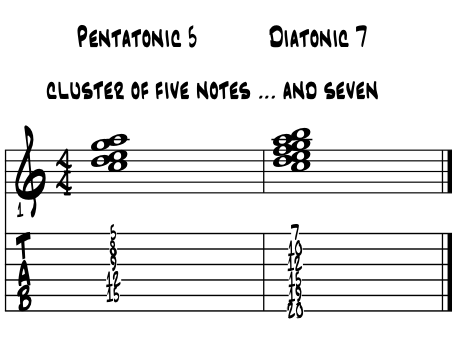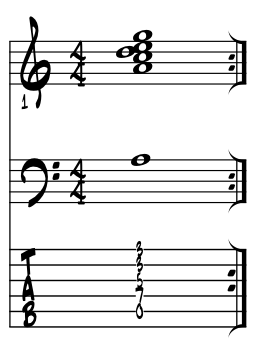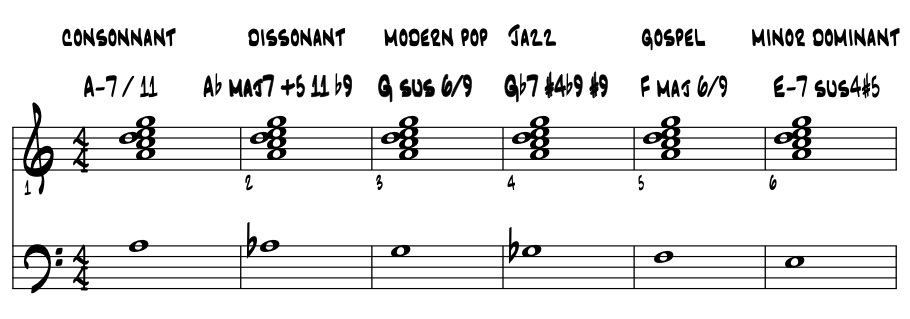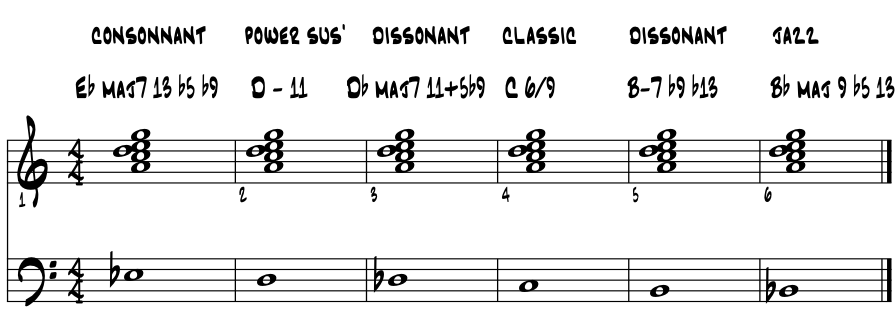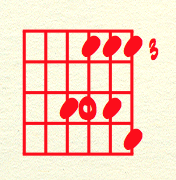~ improvisation with pentatonics ~ ~ 'our half step free zone ... :) ~ '... just starting out ... ? ~ ~ 'oldest group of pitches ... ?' ~ ~ pentatonic groups and intervals ~ ~ AmerAfroEuroLatin penta blues elevator ~ ~ find loops within loops to make modes ~ ~ make a five note chord over 12 possible roots ~ |
In a nutshell. How blessed we are as musical artists to have the five note group for sounding out melodies. We know these pitches from the wind chimes of every culture around the world; that 'all the notes in all the combinations in all the wind driven rhythms' not only near always sound good and bring a smile, but often remarkable enough to perk a musical ear.' |
|
"If it sounds good it is good." |
Theory scientists. As theory scientists, from the basis of five notes we'll build additional essential melodic resources. Five + one in minor = the blues scale. Five + one major = gospel. Five + two notes in major = the major scale / relative minor. And while there's still more notes we can add from our 12 tones, we generally don't, in creating the majority of our Americana musics. |
"In the continuing evolution of music, it must be remembered that events that appear as departure almost always have roots in the past." |
wiki ~ Ramon Ricker |
'5 ='s 7 ... the hard way :) The five pitches of the pentatonic group form a basis for creating melodies and improvising melodic lines all through the Americana spectrum of style and genres. One group of five, just as with our 'relative' major / minor group of seven pitches, works equally well ( 5 = 7 ) for creating melodies for songs in both the minor and major key centers. Melody yes ~ harmony no. As brilliant melodically as the pentatonic group is in all musics, it's ability to generate harmony is rather equally non-brilliant, actually seriously quite compromised. For when we think of our diatonic chords within a key center, we need the full seven note major / minor group to build chords and their progressions in support of melody in songs. Thinking in 'C' major, our group of five becoming seven pitches. C D E G A C D E F G A B |
Melodies over harmonies. And yet ... we know that there's an aural perfection when five note pentatonic generated melodies float over chords created from the seven note diatonic scale ... perfect. As in all things creative and beholding beauty; some melodies are nicer of course, but in working with the 'pentatonics', there's just 'never a wrong note', that there's 'no bad pitches' as the sayin' go'ed. So in starting out, to learn to sound out the Americana musics, most cats start out with the five note pentatonic colors, simply by matching up root letter name and chord quality; major or minor. ~ 'A C D E G A' notes of the 'A' minor pentatonic group sounded in a melody over any 'A' minor triad / chord ~ ~ 'C D E G A C' notes of the 'C' major pentatonic group sounded in a melody over any 'C' major triad / chord ~ Etc. :) |
Five notes in action. Here's a cycle of V7 chords a la "Sweet Georgia Brown", and finding a pentatonic group of pitches for each chord as it comes along. Example 1. |
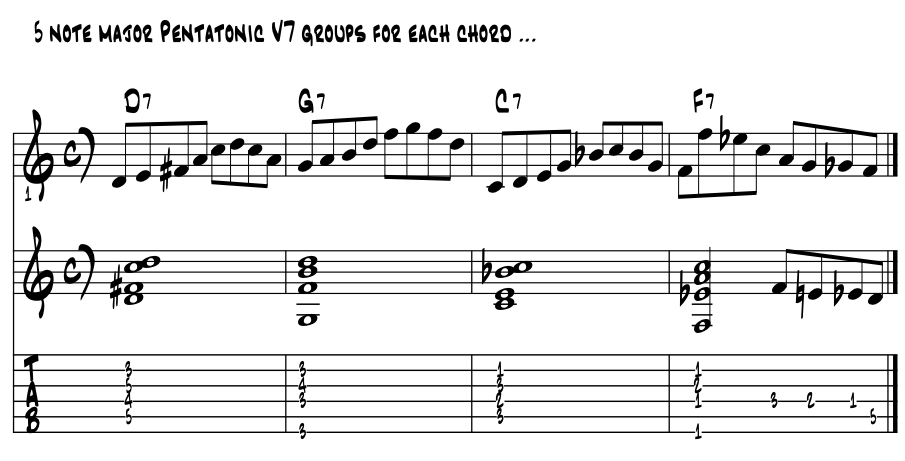 |
Does going faster help to hear the chord changes in the melody line? If so, yea man, that's one idea behind the evolutions of improvisation of Americana musics. If all this magic worked like a charm, why do we need arpeggios and scales in our improvisations? Well like most things, too much of a good thing can turn out to be too much of a good thing :) For often it's in the mix of a few good things, a collaging together, that makes a piece of art more universal in its nature. In improvisation, we can combine individual pitches, triads, full scales and modes, arpeggios and pentatonic groups to weave into our melodies, motored by time and rhythm. We make our music up as the music moves along, capturing the essential magics of the moment for all who partake in the communion through music. |
|
Just starting out ? When first starting out improvising melodies, this five pitch group, commonly called a 'pentatonic scale', provides an easy ( the way easy ) way to mix your own creative into whatever music is going down around you. For in any performance setting, and in every style, with any mix of musicians and instruments, if all fairly tuned in pitch, this five note group of pitches is pure melodic making magic. That any of the melody ideas we create from this scale, blended into the mix of the music going down, bass line story, chords etc., will sound just fine. Of course rhythm counts too in making it all groove right along :) Compare the five and seven pitch groups. Example 1. |
Hear anything too dissonant for your tastes ? The five notes have a ring, of a clarity not in the seven pitches. The two additional pitches, the Four and Seven degrees, create some overtone wobble in the overall sonority. Examine the letter names in 'C.' Example 1a. |
scale # degrees |
1 |
2 |
3 |
4 |
5 |
6 |
7 |
8 |
C pentatonic major |
C |
D |
E |
. |
G |
A |
. |
C |
C major scale |
C |
D |
E |
F |
G |
A |
B |
C |
No Four no Seven. Means no tritone dissonance (F - B), and no half steps intervals. Hmm, our two sources of aural dissonance within the diatonic realm ? |
Core motor rhythm. As the 1/8 note 'doo ba doo ba' two part syllable sparks of the swing and gets a line a cookin', having a fistfull of all good pitches is fun. With shedding to gain facility, all of a sudden 'everything pentatonic' we play sounds fine, in many a style if not all. Guitarists have this 'fistfull' of a puzzle to master.
In the early days we quipped; 'no bad notes' in the pentatonic group of pitches. Today of course we say that 'they're all good.' And after a year or so of doing this ? You'll know it too. |
All up from here. So with grouping just five, created from the 12 pitches we have in total, we've a lot of room for growth, Each new pitch added creates pathways to explore. And when we get to 12, we're done :) Whole tamale. Bingo and into the bonus round :) These discoveries become the discussions titled 'groups of pitches', a note by note additive process of these 5 on thru 12 chromatic. The bonus ? A portal to beyond. |
Know too that there's a colossal network of 'schools' for the pentatonics in Americana art. Established 1960 by Coltrane at Atlantic Studios in NYC, past and today's school locations can include every gig in America. And every Americana gig globally too. For just like the blue colors, the pentatonic color creates its own complete empire of literature, a curriculum of study through style and genres from 'a to z.' So spanning full on our folk to jazz style spectrum plus everything in between. STGC.
and R. O. ! |
Five notes of pure grace. All the world over the five pitches of the major pentatonic scale brings big joyful melodies to all who hear its powers. Strong in minor too, passionate and balanced, the minor five is always just one note away from our purely Americana blues group of pitches. These pitches of the minor group also create essential bass storylines for the blues and rockers, thus weave through all Americana musics. That the jaunty major group of pitches can usually float up melodies that will always bring a smile, taken together, both win every time. |
For all beginners, these five note groups were most likely the first ones all of us learned. Ask an intermediate guitarist what licks they learned first, and chances are it'll be pentatonic or blues color. So five or six pitches. |
And no surprise, for all of the pitches in these groups created nice consonant intervals and sonorities over chords and their progressions in songs. With its perfect major minor balance of pitches, each side bringing all the good notes, no surprise really that this same five pitch group has been grafted onto complex jazz harmonies. They then form a basis for improvising melodies through complex chord progressions. |
Improvisations including 'advanced pentatonic ideas' of sounds as 'modern' as jazzers might get nowadays. There's the chromatic blur filtering of course, and leaning to all chords are V7 chords, plus even 1/8th note styling to power the lines, they all combine to sound super modern. Blaze the tempo and hello :) |
Since the 1960's, a new school of thought was pioneered by Coltrane, who after exhausting 'through the changes' and V7b9 substitutions, found a new way to use a major pentatonic scale for each new chord of the progression in his composition "Giant Steps." Revolutionary at the time, by today of 2020, we've a solid 60 years of literature that features a 'pentatonic evolution' in a style we mostly know today as 'jazz fusion.' And through these decades of creating art, successive generations of artists created a whole new language alive still today, which we can learn and inherit its legacies. |
|
In the jazz fusion stylings, whose harmonic progressions have more rock roots and funk bass storylines, the advancing jazz leaning artists often apply the myriad of available pentatonic colors over vamp figures, a cycle of one or a couple of chords. In this setting we discover the 'pentatonic modes' and their interval configurations permutated, creating additional new color cells of five pitches, commonly moved chromatically, all sequenced into patterns and woven over the steady, often repetitive rhythms of a vamp. It's a pretty vast palette, potentially thoroughly modern, fun to play and great dance music. |
We also apply these colors to our three chord types; the One / Two / Five chords and all their colortones. In this approach our basic loop is presented from each of the 12 pitches of the chromatic scale. Spelled out in letter name pitches, we can easily locate groups with the pitches we need to blend and imply the pitches of any chord. Just like spelling chords with full on diatonic arpeggios, but in a sleeker shape, capable of incredible musical feats. |
And the flip side. To create new harmonies by placing one five note cell over each of the 12 pitches of the chromatic scale. Functioning as 12 root pitches, we'll get near a dozen stock new harmonies. Jazz up the voicings and voila, new palette :) And while the results do vary in sonority and diatonic potential, each is just a raw new color to explore. So if U hear something that grabs your attention, and now curious about, then off to the shed. |
These theory building approaches are jazz, and modern. Yet the color minor pentatonic group is one pitch away from the blue colors. U decide what works how, and find ways to make music with ancient colors now mixed still today into very complex weaves of global melodies and chords ... and topped with the fine arts of Americana improvisation. |
Quick review. Presented in the following discussion are the basics of the basics evolved into way advanced complexity. There's a modal approach, finding loops within loops. And changing up the intervals within the scale to find some basic coolness beyond the basics. And placing one color atop a dozen different root notes and seeing what harmonies pop out. Its hoped with this basic theory that the student will continue to explore this vast vast colorful and quite friendly five pitch universe. |
For guitarists, this five note group recreates some ancient patterns on the strings, so as to tie us into the 500 years or so of string playing with fretted instruments. Our Americana musics and its theories bases a ton of stuff on this one pentatonic shape. Rote learn it here and now if need be and join all of our traditions. As so below :)
|
Basic intervals. The following theory essentials come directly from Ramon Ricker's book about the application of the pentatonic colors in jazz. To create various groups of these five pitches, a first option is to explore their intervals. Examine the following chart of letter name pitches. Thinking pure 'C' major / A minor pentatonic pairing. Note; no half steps in the grouping. Example 1. |
formula |
. |
1 |
1 |
min 3 |
1 |
min 3
|
C penta major |
C |
D |
E |
G |
A |
C |
Three steps ( 1 ) and two minor 3rds ( min 3 ). Look familiar? Cool, yea this is often among the first of the groups we rote learn when starting out with music. 'No bad pitches' / 'all good pitches' = no half steps ? Could very well be. And sometimes, the major group makes nicer lines over 'A' minor than 'C' major, depends on the mood I guess :) Many improvisors use this trick; major over minor and vice versa. Here's the chart for 'A' minor. Same pitches, just a different interval pattern. Example 1a. |
formula |
min 3 |
1 |
1 |
min 3
|
1 |
|
A minor penta |
A |
C |
D |
E |
G |
A |
 |
Hearing the major minor ? Cool. This pairing of major / minor in the same pitches is our musical Yin / Yang. |
|
From 12 pitches. Knowing what we know about our equal temper tuned up piano and 12 relative key centers, we have the same options with the pentatonic group of five pitches. So same to assume that we can project these groups of pitches from each of the 12 pitches of the chromatic scale? Absolutely. Seven days a week :) And in doing so, we can borrow these five note scales from different roots as they apply to the harmonies in our chord progressions. For example, the 'Eb' major pentatonic group is a lovely group of pitches for creating melodic ideas over most any 'C' minor chord. No bad notes and it bolts right up. 'Eb F G Bb C = C Eb G Bb etc. |
Find the modes, 'loops within loops.' Can we modalize the pentatonics? Sure, why not. Just as with the old church modes, created from the seven pitches of the diatonic scale, we can 'modalize' the five notes of the pentatonic colors the same way. Using letter names for the pitches and staying in 'C' major, examine the following chart. Example 2. |
C penta major |
C |
D |
E |
G |
A |
mode I |
D penta sus 4 |
D |
E |
G |
A |
C |
mode II |
E penta minor |
E |
G |
A |
C |
D |
mode II |
G penta sus 4 |
G |
A |
C |
D |
E |
mode IV |
A penta minor |
A |
C |
D |
E |
G |
mode V |
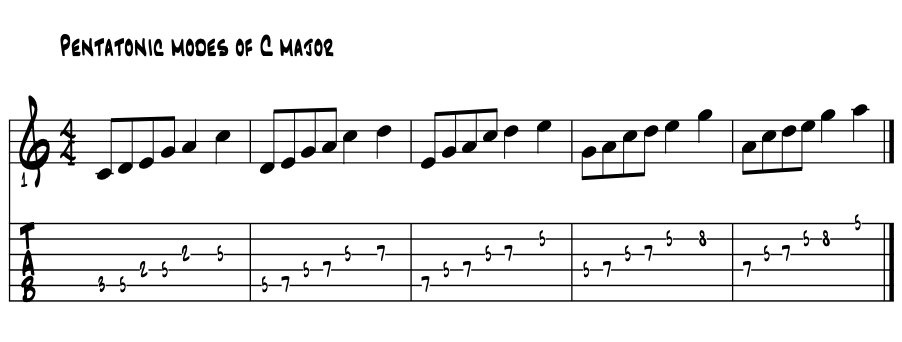 |
Easy enough yes? Just looping within loops. So with one group of five pitches we create the five modes. This basic theory just concluded here opens into a whole study of pentatonics by Ramon Ricker. |
Modes in minor. Just as with the old church modes, we can 'modalize' the pentatonic colors. In 'A' minor. Example 2a. |
A penta minor |
A |
C |
D |
E |
G |
mode I |
C penta major |
C |
D |
E |
G |
A |
mode II |
D penta sus 4 |
D |
E |
G |
A |
C |
mode II |
E penta minor |
E |
G |
A |
C |
D |
mode IV |
G penta minor |
G |
A |
C |
D |
E |
mode V |
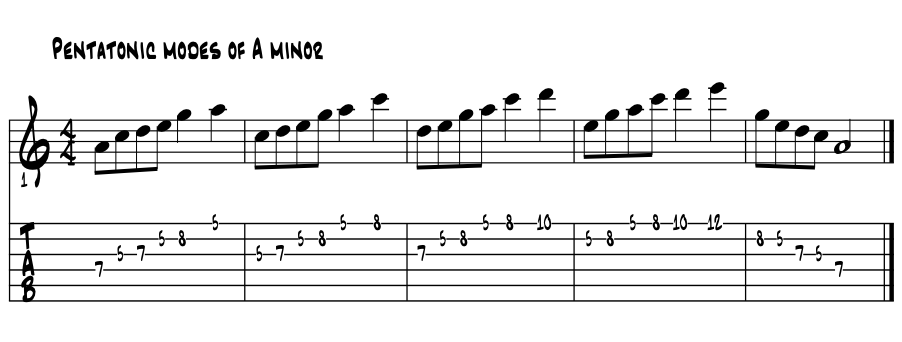 |
Easy enough yes? Here' the minor color close. Again, just looping within loops. So with one group of five pitches creates the five modes. So, 1 x 5 x 12 = 60 yes? |
Over the 12 possible root pitches. In this next excursion of this theory discovery, we take five pitches, make them into a chord, and sound them over each of our 12 pitches as root notes, and let our ears decide which ones we like. This idea comes to us here from Andrew Jaffe's exciting book titled "Jazz Theory." Then using conventional harmony guidelines we can figure out and label the ones we like and presto, a five note parent scale of all good pitches :) So continuing on here with the last group of pitches of 'A' pentatonic minor from just above, we now stack these pitches into a chord and root them over a low 'A.' Ex. 3. A C D E G A = A-7 sus 4 Sound familiar? Click it again. Saturate your ears a bit with this purity of 'consonance', that by now has based up a couple of millennia of our musics. A modern color, yet ancient too. One more click maybe ? Got it ? Cool. For these pitches meld into a 'cluster of consonance', perhaps the easiest group to find of an aural perfection of natural pitches sounded together, here as grouped and tuned, and sounded together into piano chords. Piano wise, this first pattern of intervals is the 'built right in' structure of a piano's black key pattern, as well as the white keys, stem to stern, core DNA. So all the way up and down the keyboard? Yep. All the way. Example 3a. |
 |
Takeaway / reverse engineer. The quest of this inquiry is to understand how to build an 'all good notes', five pitch pentatonic scale, for any style of harmony that comes along in our songs. And also to show how one group of five pitches works as a parent scale for a few different sounding chords, both diatonic to the five pitches and non diatonic, as determined by our root note. |
So while not unlike our major minor systems for creating parent scales and modes, remember here we're using just a five pitch cell; so it's sleeker, thus quicker and multi-combinational, creating some stunning variations through their interval arrangements. |
Creating new a new palette of colors. With this in mind, let's examine the aural colors created with our one chosen group of five consonant pitches, now set atop each of 12 possible root pitches of the chromatic scale. Since we've 12 total, we'll do a 'six and six', then a full on combo. Anything 'consonant' is up to U :) Example 3c. |
works fine, all diatonic pitches |
complex color, rare to pair colortones of maj 7 and b9 |
works fine, all diatonic pitches |
nice altered V7 chord, though complex |
works fine, all diatonic pitches |
all diatonic pitches, #5/b6 is very potent colors in minor |
complex color, rare to pair colortones of maj7 and b9 |
works fine, all diatonic pitches
|
complex |
works fine, all diatonic pitches |
-7th chord with b9 is rare |
jazz maj 9 / 13 b5 |
A mixed bag it seems. Hear anything that will work for you? We are really just sifting pitches here. We know diatonic works of course, in a key center or even when leaning polytonal, layering a strong sense of key centers by stacking major triads. This pentatonic process is very similar to finding triads in the upper structure of blues and jazz chords with color tones, and 'filtering' triads various ways. A most common example of this could be the 'G' major triad up in 'E' 7#9.' Example 3d. |
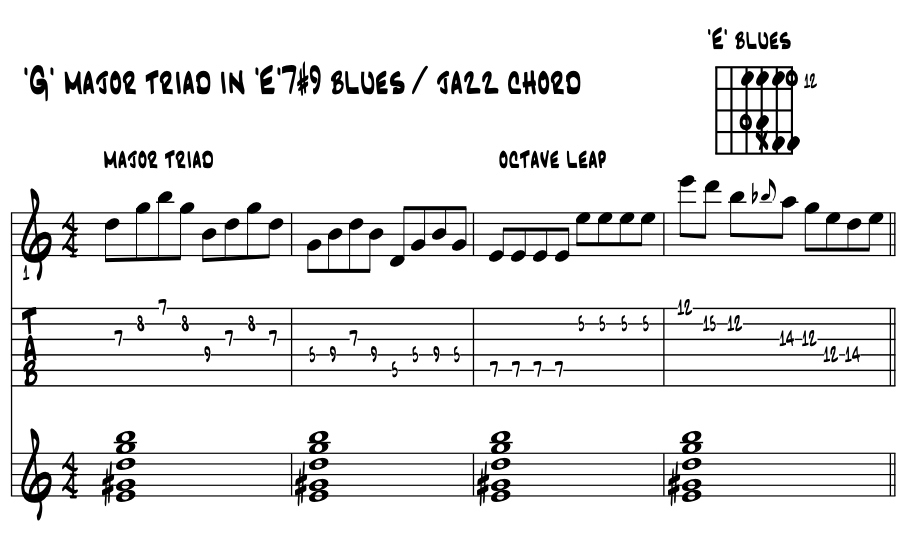 |
These sorts of ideas are 70's jazz / rock fusion mostly. Superimposing triad ideas over one chord vamps etc. All sorts of ways to view, mix and permutate our resources. For guitarists, the John McLaughlin / Carlos Santana album, "Love Devotion Surrender", dedicated to Coltrane's work on a "A Love Supreme", provides a stunning new window into this level of complexity of musical art, and the chops to pull it off. Knowing the theory evolutions or not, these are incredible collection of musical art pieces to behold. |
|
Permutate the intervals. In these next ideas, in creating groups of five pitches, we break the basic rule of thumb; that there can not be two minor 3rd intervals together. Once we move past this barrier, some new opportunities blossom. And while we loose some of the 'all good pitch' magics we associate with the 'correct' pentatonic formula, we're just being scientists really, looking at these melodic, multifaceted gems from many angles. Here we bend the original pentatonic basis of avoiding two minor 3rd intervals together, and bend to make three new groups. Here's our ancient start point again followed by our new permutations. Thinking from the root 'C.' Example 4. |
formula |
. |
1 |
1 |
min 3 |
1 |
min 3
|
C penta major |
C |
D |
E |
G |
A |
C |
formula |
. |
min 3 |
min 3 |
1 |
1 |
1
|
C half diminished |
C |
Eb |
Gb |
Ab |
Bb |
C |
formula |
. |
1 |
min 3 |
min 3 |
1 |
1
|
C penta 11 |
C |
D |
F |
Ab |
Bb |
C |
formula |
. |
1 |
1 |
min 3 |
min 3rd |
1
|
C 7 |
C |
D |
E |
G |
Bb |
C |
formula |
. |
1 |
1 |
1 |
min 3 |
min 3
|
C 7 / V7 |
C |
D |
E |
Gb |
A |
C |
Grist for the mill. As Dr. Miller would often said, 'just so more grist for the mill o'l boy.' Meaning ? Well, sift through the pitches and groups, and see if there's something there for creating the art in your heart. The 'half diminished' is leaning to 'altered.' Which generally implies a combination of diminished and whole tone colors within one group of pitches, for creating a scale or chord. The 'C7' entry, just one pitch off the original formula, is one I've gotten some miles out of as it forms a handy shape moving across the strings.
|
Review. So with the five pitches within the octave span we've all sorts of goodness to explore. 'All good pitches' makes it a common start off point for many emerging artists for their own improvisational journey of self discovery and expression. On the advancing levels, there's a whole curriculum of study and a mountain of music from 1960 or so onward, that centers on this group of five pitches. Amazing all 'round, a basis within all of our styles, we find the these pentatonic colors creating a spectrum of music from wind chimes, to elementary songs for children, to advanced jazz complexities, which bring an ancient familiarity of these pitches, shared by all, through the melodies they can create. |
"Simplicity is the ultimate sophistication." |
wiki ~ Leonardo da Vinci |
Garage bands. How blessed we are as musical artists to have the five note group for sounding out melodies. For as a group of pitches they go all the way back in time yet today we can hear kids singing pentatonic melodies on any playground all around the world ... wind chimes in the distance. Tune into radio USA and the pentatonic colors still blare and fill dance floors every Saturday night coast to coast. Whether sittin' out in nature with an acoustic or 'Tele rockin' Arrowhead Stadium in KC, these five notes bring the magic every time, and alway have. How can this be ... ? |
|
Especially in minor. Well, we the aural artists always love having Pentatonic's ancient 'no bad pitches' magic. For all of us can solo and collectively sound out these notes in any order, in any style, on any instrument, with any effects, over any groove and it'll be music, your music, all sounding good and familiar. For even a wobbly groove, yet with a steady beat, moving through measurable time, with a pulse to create some gravity, the pentatonic five have always made us and our musics sound good. And surely we know and believe that ... |
References. References for this page's information comes from school, books and the bandstand and made way easier by the folks along the way. |
Find a mentor / e-book / academia Alaska. Always good to have a mentor when learning about things new to us. And with music and its magics, nice to have a friend or two ask questions and collaborate with. Seek and ye shall find. Local high schools, libraries, friends and family, musicians in your home town ... just ask around, someone will know someone who knows someone about music and can help you with your studies in the musical arts. |
|
Always keep in mind that all along life's journey there will be folks to help us and also folks we can help ... for we are not in this endeavor alone :) The now ancient natural truth is that we each are responsible for our own education. Positive answer this always 'to live by' question; 'who is responsible for your education ... ? |
Intensive tutoring. Luckily for musical artists like us, the learning dip of the 'covid years' can vanish quickly with intensive tutoring. For all disciplines; including all the sciences and the 'hands on' trade schools, that with tutoring, learning blossoms to 'catch us up.' In music ? The 'theory' of making musical art is built with just the 12 unique pitches, so easy to master with mentorship. And in 'practice ?' Luckily old school, the foundation that 'all responsibility for self betterment is ours alone.' Which in music, and same for all the arts, means to do what we really love to do ... to make music :) |
 |
"These books, and your capacity to understand them, are just the same in all places. Always bear in mind that your own resolution to succeed, is more important than any other one thing." |
|
Academia references of Alaska. And when you need university level answers to your questions and musings, and especially if you are considering a career in music and looking to continue your formal studies, begin to e-reach out to the Alaska University Music Campus communities and begin a dialogue with some of Alaska's finest resident maestros ! |
